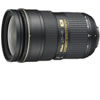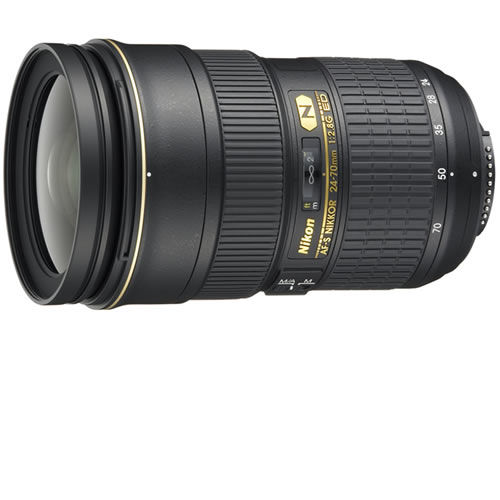- Webcode: 233582 • Mfr: 2164
- FREE SHIPPING Available
Product Highlights
- f/2.8 - f/22 Aperture Range
- 15/11 Elements/Groups
- SWM Silent Wave Motor
- Dust & Water Resistant
- 77mm Filter Diameter
- Nikon F Mount

Nikon AF-S NIKKOR 24-70mm f/2.8 G ED Lens
Nikon AF-S NIKKOR 24-70mm f/2.8 G ED...- Toronto Special Order
- Ottawa Special Order
- Mississauga Special Order
- Calgary Special Order
- Edmonton Special Order
Used available:
Overview
Nikon AF-S 24-70mm
f/2.8 G IF-ED Nikkor Zoom Lens
The Nikon AF-S Nikkor 24-70mm f/2.8G ED Autofocus lens is a fast aperture standard zoom lens designed for photojournalism and general photography. Optimized for edge-to-edge sharpness on both the Nikon FX (full-frame) and DX-format image sensors, this lens also includes two ED (Extra-low Dispersion) elements and PGM aspherical lenses that help control chromatic aberrations while enhancing sharpness and contrast, even at the widest aperture settings.
The Silent Wave Motor (SWM) feature provides swift autofocus with superior accuracy and ultra-quiet operation. This G-type lens does not feature an aperture ring on the lens body, resulting in a lighter and more compact lens. Aperture changes are designed to be done via the camera's command dial.
* 'G' lenses are not fully compatible with the F4, N90-series, N70, N8008-series and N6006 (or older model) cameras, only programmed auto or shutter-priority auto exposure mode can be used.
Key Features:
- Constant maximum aperture of f/2.8 at all focal lengths
- Enhanced optical formulas, engineered to produce exceptional sharpness, contrast and color, render outstanding image integrity
- ED (Extra-low dispersion) glass elements minimize chromatic aberration to deliver stunning sharpness and contrast
- Aspherical lenses including large-diameter PGM element eliminate various types of lens aberration even at the widest aperture
- Nano Crystal Coat virtually eliminates internal lens element reflections
- High-performance Nikon Super Integrated Coating offers superior color reproduction, while minimizing ghosting and flare
- IF (Internal Focusing) enables focusing without changing the length of lens barrel
- Nikon’s exclusive Silent Wave Motor for fast, quiet autofocus operation
- Rounded diaphragm opening (9 blades) makes out-of-focus elements appear more natural
- 0.38 m/1.2 ft. closest focusing distance with focal length 35-50 mm
- Filter attachment size of 77 mm
- M/A mode enables instant switching from autofocus to manual focus, even during AF servo operation, with virtually no time lag
- Lens barrel is built for comfortable holding while featuring a rugged design; zoom and focusing rings provide smooth operation
- Engineered to Nikon professional D-SLR standards to effectively resist dust and moisture
ED glass — an essential element of NIKKOR telephoto lenses
Nikon developed ED (Extra-low Dispersion) glass to enable the production of lenses that offer superior sharpness and color correction by minimizing chromatic aberration.
Put simply, chromatic aberration is a type of image and color dispersion that occurs when light rays of varying wavelengths pass through optical glass. In the past, correcting this problem for telephoto lenses required special optical elements that offer anomalous dispersion characteristics — specifically calcium fluoride crystals. However, fluorite easily cracks and is sensitive to temperature changes that can adversely affect focusing by altering the lens’ refractive index.
So Nikon designers and engineers put their heads together and came up with ED glass, which offers all the benefits, yet none of the drawbacks of calcium fluorite-based glass. With this innovation, Nikon developed several types of ED glass suitable for various lenses.
They deliver stunning sharpness and contrast even at their largest apertures. In this way, NIKKOR’s ED-series lenses exemplify Nikon’s preeminence in lens innovation and performance.
Nikon Super Integrated Coating ensures exceptional performance
To enhance the performance of its optical lens elements, Nikon employs an exclusive multilayer lens coating that helps reduce ghost and flare to a negligible level.
Nikon Super Integrated Coating achieves a number of objectives, including minimized reflection in the wider wavelength range and superior color balance and reproduction. Nikon Super Integrated Coating is especially effective for lenses with a large number of elements, like our Zoom-NIKKOR lenses.
Also, Nikon's multilayer coating process is tailored to the design of each particular lens. The number of coatings applied to each lens element
is carefully calculated to match the lens type and glass used, and also to assure the uniform color balance that characterizes NIKKOR lenses. This results in lenses that meet much higher standards than the rest of the industry.
Nano Crystal Coat
Nano Crystal Coat is an antireflective coating that originated in the development of NSR-series (Nikon Step and Repeat) semiconductor manufacturing devices. It virtually eliminates internal lens element reflections across a wide range of wavelengths, and is particularly effective in reducing ghost and flare peculiar to ultra-wideangle lenses. Nano Crystal Coat employs multiple layers of Nikon’s outstanding extra-low refractive index coating, which features ultra-fine crystallized particles of nano size (one nanometer equals one millionth of a mm). Nikon now proudly marks a world first by applying this coating technology to a wide range of lenses for use in consumer optical products.
Aspherical lens elements
Nikon introduced the first photographic lens with aspherical lens elements in 1968. What sets them apart? Aspherical lenses virtually eliminate the problem of coma and other types of lens aberration — even when used at the widest aperture. They are particularly useful in correcting the distortion in wideangle lenses. In addition, use of aspherical lenses contributes to a lighter and smaller lens design.
Nikon employs three types of aspherical lens elements. Precision-ground aspherical lens elements are the finest expression of lens-crafting art, demanding extremely rigorous production standards. Hybrid lenses are made of a special plastic molded onto optical glass. Molded glass aspherical lenses are manufactured by molding a unique type of optical glass using a special metal die technique.
Internal Focusing (IF)
Imagine being able to focus a lens without it changing in size. Nikon’s IF technology enables just that. All internal optical movement is limited to the interior of the nonextending lens barrel. This allows for a more compact, lightweight construction as well as a closer focusing distance. In addition, a smaller and lighter focusing lens group is employed to ensure faster focusing. The IF system is featured in most NIKKOR telephoto and selected NIKKOR zoom lenses.
Distance information
D-type and G-type NIKKOR lenses relay subject-to-camera distance information to AF Nikon camera bodies. This then makes possible advances like 3D Matrix Metering and 3D Multi-Sensor Balanced Fill-Flash.
G-type NIKKOR
The G-type NIKKOR has no aperture ring; aparture should be selected from camera body.
Silent Wave Motor
Nikon’s AF-S technology is yet another reason professional photographers like NIKKOR telephoto lenses. AF-S NIKKOR lenses feature Nikon’s SWM which converts “traveling waves” into rotational energy to focus the optics. This enables high-speed autofocusing that’s extremely accurate and super quiet.
M/A mode
AF-S NIKKOR lenses feature Nikon’s exclusive M/A mode, that allows switching from autofocus to manual operation with virtually no time lag — even during AF servo operation and regardless of AF mode in use.
What's Included
- Nikon AF-S 24-70mm f/2.8 G IF-ED Nikkor Zoom Lens
- Bayonet Hood HB-40
- Semi-soft Case CL-M3
- Front Lens Cap
- Back Lens Cap
- Limited Warranty
Reviews
Product Specifications
| Detailed Specifications | |
|---|---|
| Focal length | 24-70 mm |
| Maximum aperture | f/2.8 |
| Minimum aperture | f/22 |
| Lens construction | 15 elements in 11 groups (with 3 ED glass elements, 3 aspherical lenses and one Nano Crystal Coat) |
| Picture angle | 84° - 34°20’ (61° - 22°50’ with DX-format camera) |
| Closest focus distance | 0.38 m/1.2 ft. (with focal length 35-50 mm |
| Maximum reproduction ratio | 1/3.7 |
| No. of diaphragm blades | 9 (rounded) |
| Filter/attachment size | 77 mm |
| Focusing | Internal Focusing (IF) system; autofocus with a built-in SWM and manual focus |
| Diameter x length (extension from lens mount) |
Approx. 83 x 133 mm/3.3 x 5.2 in. |
| Weight | Approx. 900 g/31.7 oz. |
| Supplied accessories | Bayonet Hood HB-40, Semi-soft Case CL-M3 |
Questions & Answers
Nikon AF-S NIKKOR 24-70mm f/2.8 G ED Lens
Looking for a personal touch? Not sure if you are choosing the right product? Our staff is here to help.
We want to make sure you get the right product for your needs.
Our staff will help you understand the options available so you can be confident in your purchase.
As the country’s leading Professional Imaging retailer, Vistek is in the perfect position to ensure you make the right choice.
Contact us today for a personal touch.


